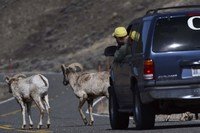May 2, 2013
Early Spring in Yellowstone
Post Register May 2, 2013
A small group of visitors lounged in a pullout in Lamar Valley in Yellowstone National Park. Their spotting scopes were all trained high up on the opposite slope at a point about 1.5 miles away. Curious, we asked what could possibly interest them at such a distance. A grizzly bear, they said, was emerging from its den. Sure enough, when we located the snow-covered spot, we could see where the bear had been milling around the densite, probably for several days. After all, for a grizzly, waking up isn’t a matter of jump out of bed and hit the showers. It is a process that occurs over several leisurely days.
The Park itself is like that. It wakes up slowly from its winter’s nap as the snow reluctantly recedes, unveiling a new story one glorious page at a time.
Early spring in Yellowstone isn’t the prettiest or the easiest time to “read” the Park. The ink is still wet on the few pages that are available. The higher country is still snow-covered and roads are wrestled open one by one. You can now drive from West Yellowstone to Mammoth or Old Faithful, but traveling the Grand Loop over Dunraven Pass is still almost a month away. Lamar Valley is accessible all year, but road construction has the road to Tower Falls closed almost until June. Backtracking is the rule of the day and, “you can’t get there from here” is the motto.
Early spring is a great time to bicycle before traffic builds to life threatening levels. Be sure to dress well though, as much of the Park is still on the edge of winter. Most hiking trails remain covered in snow and those that aren’t are often slick with mud. Start with the lowest elevation trails from Mammoth to Lamar Valley on south faces for early hiking enjoyment.
Early spring visits are not for the pampered. Most services and facilities are closed. There is no fuel, few places to buy food, and only the Mammoth Campground is open. Many of the motel rooms in Gardiner are booked on the weekends, so planning ahead is important too.
People don’t go to Yellowstone in the early spring for the scenery. Wildlife is the attraction and spring may be the best time to see animals before they spread out into the higher country. Although you can encounter wildlife almost anywhere, for the most part, viewing wildlife means heading to Lamar Valley at the north end of the Park. Here you can enjoy about every larger mammal species that calls the Park home. In one weekend we saw: bison, including newborn calves, elk, mule deer, moose, pronghorn antelope, bighorn sheep, grizzly bears, black bears, wolves, marmots, a badger, and coyotes. Trumpeter swans, sandhill cranes, various duck species, Canada geese, bald eagles, and red-tailed hawks rounded out the bird list. And this was from the vehicle. With the exception of the wolves, they were close to the roads.
Although we pretty much know how the Yellowstone story will unfold, it is always a joy to be there when it starts anew and watch the pages turn. It is one book I can read every year.
By Terry Thomas
A visitor photographs bighorn sheep rams in Yellowstone’s Lamar Valley near Soda Butte on April 27th. Once the sheep move to the high country, they will be hard to find.
